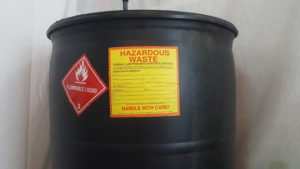Question:
I’d like to commend you for the great Q&A on your website. I have referred others to answers on HW and HM Qs over the years, as you always do a great job of explaining why something does/doesn’t apply. I saw your answer that there is no RQ for gasoline as an HM: Q&A: How much diesel fuel is a reportable quantity (RQ) of a hazardous substance?, but what about when it’s waste gasoline? As it carries a D001 waste code it seems like it would apply in cases where it exceeds the D001 threshold (100 lbs).
Answer:
Thank you for contacting me. You are correct, as a hazardous waste with the D001 waste code, gasoline could be a RQ of a hazardous substance. In that case though the RQ applies to the D001 and not to the gasoline.
Please see below for clarification:
- As documented in the above-referenced article, the definition of hazardous substance at 49 CFR 171.8 of the USDOT/PHMSA Hazardous Materials Regulations specifically excludes petroleum and related substances:

The term does not include petroleum, including crude oil or any fraction thereof which is not otherwise specifically listed or designated as a hazardous substance in appendix A to § 172.101 of this subchapter, and the term does not include natural gas, natural gas liquids, liquefied natural gas, or synthetic gas usable for fuel (or mixtures of natural gas and such synthetic gas).
- Gasoline and diesel as a petroleum product are excluded from consideration as a hazardous substance and therefore can’t have a reportable quantity (RQ).
- However, the list of hazardous substances at Appendix A to § 172.101—List of Hazardous Substances and Reportable Quantities includes the USEPA hazardous waste code for Ignitability (D001) with a RQ of 100 lb.
- It is quite likely that gasoline as a waste for disposal will have the Characteristic of Ignitability and the D001 waste code. It is less likely – though possible – that diesel fuel as a waste will have the Characteristic of Ignitability and the D001 waste code.
- As noted above, the reportable quantity (RQ) of D001 in a single container is 100 lb. Therefore, if a single container we



